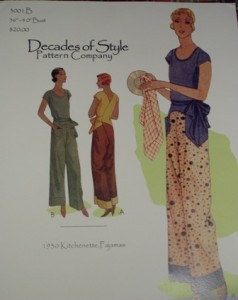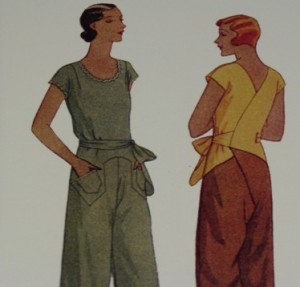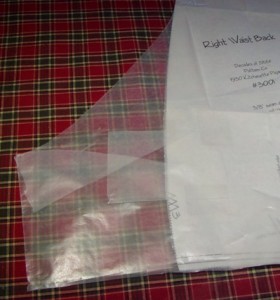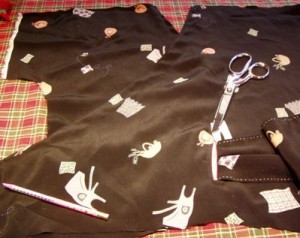 I love vintage patterns. Sometimes I think it’s because of the artwork on the envelop front but in general there seems to be a bit more romance involved in any case. And, in Aunt Toby’s ever-expanding search for something to wear while asleep and/or lounging about that is not sweatpant/athletic shorts/tee shirt, I found this reworked pattern from Decades of Style, which is called ‘Kitchenette Pajamas”.
I love vintage patterns. Sometimes I think it’s because of the artwork on the envelop front but in general there seems to be a bit more romance involved in any case. And, in Aunt Toby’s ever-expanding search for something to wear while asleep and/or lounging about that is not sweatpant/athletic shorts/tee shirt, I found this reworked pattern from Decades of Style, which is called ‘Kitchenette Pajamas”.
Now, the cover speaks (as did housedress patterns up through about 1960) directly to the use of this pattern. The young lady on the cover, the biggest illustration, is washing dishes. Ah – this is a clever take on a housedress, but something done as a wrap-around jumpsuit and if you made it in something a bit more interesting or chic than ‘housedress cotton’, you could get something that you could lounge around in – hence the use of the term ‘pajamas’ (which at that time were seen as loungewear for women and were even worn at the beach!). So, our young lady in her ‘kitchenette apartment’ (all very independent and obviously making enough scratch in 1930 during the Great Depression that she could have an apartment, even if she had to share it with the other two girls on the cover of the pattern who seem to be having a private conversation there in the background) is finished with work and is doing her washing up.
So, here are some of the fiddly bits to this pattern:
1) This to me is sort of weird, given that 1930 was in the depths of the Great Depression and people were squeezing every penny — this pattern takes a LOT of fabric. I made this first as a muslin and then pulled out 3 yards of rayon poly something (it’s not challis but more like a crepe) that is at least 45″ wide. I’m short – only 5’2″ and I am used to being able to get a skirt out of a yard of 45″ wide fabric. Both times, I have faced running out of fabric and having to do something clever. In this case, I went through the stash and found some pink poly lining that matched one of the little illustrations in what I think is called ‘conversational print’ of this navy blue fabric. So, do yourself a favor – add a yard to the yardage estimates on the pattern to make this, unless you’ve already decided to make it two colors.
2) I am short. So is this pattern. I made this pattern as/is out of the envelope. I did not shorten anything and it fits me perfectly. See the ladies on the cover with their pumps on with their pajamas? Mine hit me at the same point. So, if you are going to make this pattern, do make yourself a muslin and be prepared to make both the top half longer (split it at the waist marks and add paper); ditto on the leg portions. yes, there is a lot of ease in this pattern but ease goes around – I think anyone who is taller than 5’4″ is going to need to lengthen this in more than one spot.
3) One of the issues with this (and frankly with any wrap-around pattern — see “Dress, Walk-Away”) is that the only ‘points of control’ are the ties. As you can see with the illustration:  you can see the back on the girl on the right. The point of control (that is, where the tie is attached to the right hand back piece, is down low and relatively narrow. In every pattern review on this I have read, everyone mentions that this causes the back to sort of sag open (and it did on my muslin also). The point of control needs to be higher up on the back bodice piece, but I did not want to fiddle with the shape of the tie itself. So I did this:
you can see the back on the girl on the right. The point of control (that is, where the tie is attached to the right hand back piece, is down low and relatively narrow. In every pattern review on this I have read, everyone mentions that this causes the back to sort of sag open (and it did on my muslin also). The point of control needs to be higher up on the back bodice piece, but I did not want to fiddle with the shape of the tie itself. So I did this:
 I added a paper extension onto the lower half of the back bodice pattern piece, curving it up into the upper part of the back bodice. The width of the lower extension is the same as the width of the tie at that point, where it ordinarily would have attached. The other thing I did was that I made the sleeve extensions longer (cap sleeves are fine but I’d like something a little bit longer) and deeper since I have ‘bodacious bicep’issues (as Carolyn calls them).
I added a paper extension onto the lower half of the back bodice pattern piece, curving it up into the upper part of the back bodice. The width of the lower extension is the same as the width of the tie at that point, where it ordinarily would have attached. The other thing I did was that I made the sleeve extensions longer (cap sleeves are fine but I’d like something a little bit longer) and deeper since I have ‘bodacious bicep’issues (as Carolyn calls them).
Other Fiddly Details
The difference between “I just wear this to bed” and “Come over for drinks” is in the details. First, as mentioned before, is fabric choice. The nicer and heavier the fabric is, the more formal and ‘chic loungewear’ this will look. Second, is color choices; one long drape of color looks more formal than breaking it up as a two-color exercise. Third are construction items:
 The first things you have to do with this after cutting it out is to take care of the back bodice. The instructions tell you to do this and they are right. First thing is to deal with the ‘slit’ in the back (see the illustration where the ties come through). There are several ways to do this but one of the things to keep in mind is that this slit is a ‘point of failure’ – this is where one of the ties goes through; it will have a certain amount of stress on it. You will want to, at the very least, put some fusible interfacing on the inside when you make the slit. I faced it, in the same way we make bound buttonholes and then filled in the window with two interfaced doubled strips of the pink lining. You can see that where the scissors are pointing in the photo.
The first things you have to do with this after cutting it out is to take care of the back bodice. The instructions tell you to do this and they are right. First thing is to deal with the ‘slit’ in the back (see the illustration where the ties come through). There are several ways to do this but one of the things to keep in mind is that this slit is a ‘point of failure’ – this is where one of the ties goes through; it will have a certain amount of stress on it. You will want to, at the very least, put some fusible interfacing on the inside when you make the slit. I faced it, in the same way we make bound buttonholes and then filled in the window with two interfaced doubled strips of the pink lining. You can see that where the scissors are pointing in the photo.
The second items are the edges of the back bodice which cross over one another. The pattern calls for them to be ironed over and sewn down but depending on what sort of fabric you use for this, that might not give you the effect you want. The fabric I’m using has a tendency to stretch on the bias (which the direction of the back bodice edge produces in a curved sort of way). Since we are going to be pulling against the edge with those ties, I figured that I needed to stabilize that edge, which I did with lightweight fusible interfacing and then I bound it with bias strips of the pink lining fabric.
Next up: The Front.
